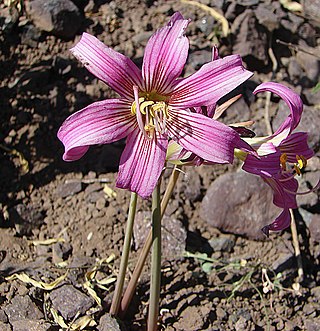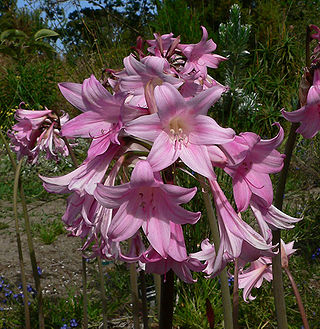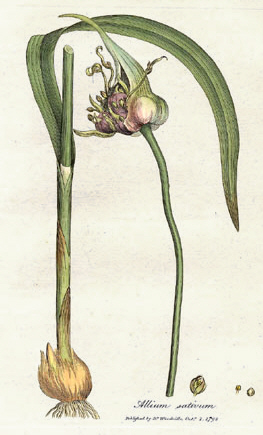
Asparagales is an order of plants in modern classification systems such as the Angiosperm Phylogeny Group (APG) and the Angiosperm Phylogeny Web. The order takes its name from the type family Asparagaceae and is placed in the monocots amongst the lilioid monocots. The order has only recently been recognized in classification systems. It was first put forward by Huber in 1977 and later taken up in the Dahlgren system of 1985 and then the APG in 1998, 2003 and 2009. Before this, many of its families were assigned to the old order Liliales, a very large order containing almost all monocots with colorful tepals and lacking starch in their endosperm. DNA sequence analysis indicated that many of the taxa previously included in Liliales should actually be redistributed over three orders, Liliales, Asparagales, and Dioscoreales. The boundaries of the Asparagales and of its families have undergone a series of changes in recent years; future research may lead to further changes and ultimately greater stability. In the APG circumscription, Asparagales is the largest order of monocots with 14 families, 1,122 genera, and about 36,000 species.

The flowering plant genus Ipheion belongs to Allioideae, a subfamily of the family Amaryllidaceae. It includes three species native to southern Brazil, northeastern Argentina, and Uruguay.

Nothoscordum is a genus of New World plants in the onion tribe within the Amaryllis family. It is probably paraphyletic. The genus is native to North, Central and South America, though a few species have become naturalized in various parts of the Old World.

Schoepfiaceae is a family of flowering plants recognized in the APG III system of 2009. The family was previously only recognized by few taxonomists; the plants in question usually being assigned to family Olacaceae and Santalaceae.

Leucocoryne(glory-of-the-sun) is a genus of bulbous perennial plants in the family Amaryllidaceae. The foliage of all species is long and narrow and has an onion-like scent. The blue, white or lilac flowers are held in umbels.
Hamilton Paul Traub was an American botanist. He specialized in the study of Amaryllidaceae. He also did horticultural studies on beans. Dr Traub was one of the founding members of the American Amaryllis Society in 1933, and for a long time the editor of its annual publication, variously called Year Book, American Amaryllis Society, Herbertia and Plant Life: Amaryllis Year Book.

Rhodolirium is a small South American genus in the tribe Hippeastreae of the family Amaryllidaceae. Although originally described by Philippi in 1858 it has long remained buried in other taxa, principally Hippeastrum and more recently Rhodophiala. Only in recent years has it been rehabilitated.

The Amaryllidaceae are a family of herbaceous, mainly perennial and bulbous flowering plants in the monocot order Asparagales. The family takes its name from the genus Amaryllis and is commonly known as the amaryllis family. The leaves are usually linear, and the flowers are usually bisexual and symmetrical, arranged in umbels on the stem. The petals and sepals are undifferentiated as tepals, which may be fused at the base into a floral tube. Some also display a corona. Allyl sulfide compounds produce the characteristic odour of the onion subfamily (Allioideae).

Amaryllidoideae is a subfamily of monocot flowering plants in the family Amaryllidaceae, order Asparagales. The most recent APG classification, APG III, takes a broad view of the Amaryllidaceae, which then has three subfamilies, one of which is Amaryllidoideae, and the others are Allioideae and Agapanthoideae. The subfamily consists of about seventy genera, with over eight hundred species, and a worldwide distribution.

Tristagma is a genus of South American plants in the onion subfamily with the Amaryllis family. It includes 17 species native to Peru, Argentina, and Chile in South America.

Solaria is a genus of South American plants in the family Amaryllidaceae, subfamily Allioideae, tribe Gilliesieae, native to Chile and Argentina. Kew treats Solaria as a synonym of Gilliesia.

Allieae is a tribe of plants belonging to the subfamily Allioideae of the Amaryllis family (Amaryllidaceae). It comprises a single genus, Allium, distributed in temperate zones of the Northern Hemisphere.

Tulbaghieae is a tribe of plants belonging to the subfamily Allioideae of the Amaryllis family (Amaryllidaceae). It comprises two genera, Tulbaghia and Prototulbaghia, native to South Africa.

Gilliesieae is a tribe of herbaceous geophyte plants belonging to the subfamily Allioideae of the Amaryllis family (Amaryllidaceae). Described in 1826, it contains fifteen genera and about eighty species. It has been variously treated as a subfamily or tribe. It is native to the Southern United States, Central and South America, predominantly Chile. Of the three tribes of genera that make up the subfamily Allioideae, Gilliesieae is the largest and most variable. The tribe was divided into two tribes in 2014, Gilliesiae s.s. and Leucocoryneae, based on differences in floral symmetry and septal nectaries.
Erinna is a genus of perennial herbaceous geophytes in the flowering plant family Amaryllidaceae. It is native to Chile, South America. It is included in the tribe Gilliesieae, within the subfamily Allioideae. The genus is monotypic, with a single species, Erinna gilliesioides. It is relatively rare.

Allioideae is a subfamily of monocot flowering plants in the family Amaryllidaceae, order Asparagales. It was formerly treated as a separate family, Alliaceae. The subfamily name is derived from the generic name of the type genus, Allium. It is composed of about 18 genera.

Allium is a genus of monocotyledonous flowering plants with hundreds of species, including the cultivated onion, garlic, scallion, shallot, leek, and chives. It is one of about 57 genera of flowering plants with more than 500 species. It is by far the largest genus in the Amaryllidaceae, and also in the Alliaceae in classification systems in which that family is recognized as separate.

Traubiinae is a subtribe of plants classified under the tribe Hippeastreae. It belongs to the subfamily Amaryllidoideae of the Amaryllis family (Amaryllidaceae).

Famatina was a small genus of South American bulbous plants identified by the Chilean botanist Ravenna in 1972. Five species have been described. Molecular phylogenetic studies suggested the genus was polyphyletic, and species have been moved to other genera.
Atacamallium minutiflorum is a species of flowering plant in the family Amaryllidaceae. It is the sole species in genus Atacamallium. It is a bulbous geophyte endemic to Antofagasta Region of northern Chile, where it grows in the coastal Atacama Desert.
















